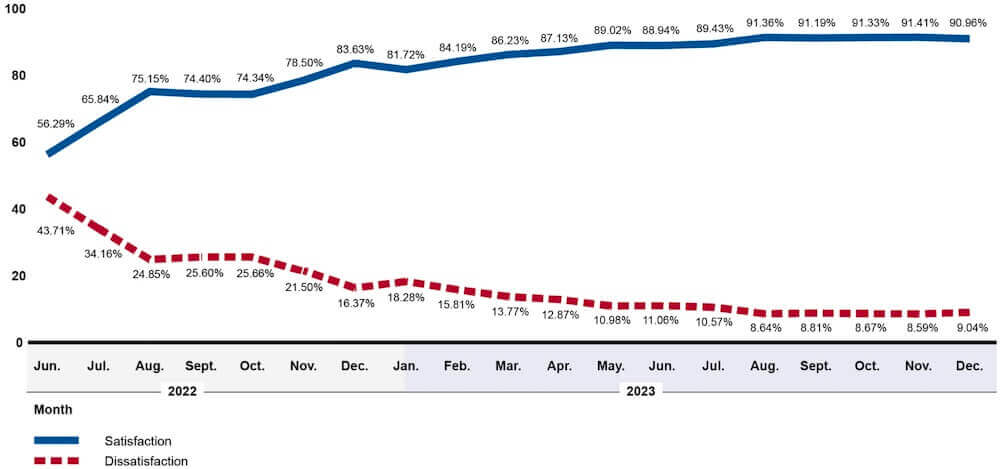In what probably won’t come as a shock to many federal employees, the Government Accountability Office said that the Federal Retirement Thrift Investment Board (FRTIB) failed to adequately oversee all necessary aspects of the development and rollout process of the new TSP website before it was launched in 2022.
The long-awaited report of its investigation into the launch of the new TSP website was requested by some Members of Congress. Among them was Congresswoman Eleanor Holmes Norton (D-DC) who held meetings with the FRTIB and called for the investigation early on when she said that the agency had failed to adequately address her concerns about the problems being reported to her office by the federal employees and retirees that they were encountering with the new website after it launched. She also called for establishing an investigator general for FRTIB.
Among the problems users reported when using the new website shortly after it was launched were:
- Being unable to access their accounts or complete basic transactions
- Obtain required minimum distributions required by IRS
- Receive beneficiary benefits and court order awards
- Get adequate assistance through the ThriftLine, the TSP’s customer support line
On the last item, wait times on hold ran multiple hours in the initial days after the launch. According to Accenture Federal Services (AFS), the contractor that FRTIB hired to rebuild the website and oversee its operation, it received about 120,000 calls on the first day of the website’s operation. The average wait time went from 35 minutes on the first day to two hours by the third day. Action was subsequently taken to address many of these problems, but it took months in some cases.
What Problems Did GAO Find?
According to GAO, while FRTIB did identify its needs and addressed alternatives to meet them, it failed to do the following:
- Develop policies and procedures to govern the way it acquires products and services until after the TSP services acquisition was underway
- Ensure that the new TSP recordkeeping system was consistent with federal requirements for loan repayment, court ordered benefits and accessibility
- Verify that AFS had completed tests in accordance with plans
- Ensure that all milestones were met before progressing through the acquisition process
- Confirm that personnel requirements for training, background investigations and contract monitoring were met
According to GAO, “By not fully implementing these practices, FRTIB significantly increased the risk of a problematic rollout of the new system.”
GAO elaborated on some of the areas where FRTIB fell short in its report:
While the agency identified its needs and assessed alternatives to meet these needs, it did not fully address other key acquisition management practices. Specifically, in planning for the TSP acquisition, FRTIB initially lacked policies and procedures for acquiring managed services and developed them while in the acquisition process. FRTIB also defined high-level requirements for the services it desired but did not ensure the TSP recordkeeping system was consistent with these requirements before the system was launched. In addition, many tests were conducted on the system, but FRTIB did not ensure that the test results demonstrated that the system met its desired performance outcomes before it was deployed. FRTIB also utilized milestone and exit criteria to support its decision for the new TSP recordkeeping system but did not always ensure that they were fully met before progressing through the acquisition process. Lastly, FRTIB established requirements for the key contractor and government personnel involved in managing and carrying out work for the TSP services contract, but the agency did not always confirm these requirements were met.
The report also noted:
In October 2020, AFS provided FRTIB a proposed solution to its statement of objectives and narratives by submitting, among other things, a contractor performance work statement. FRTIB evaluated the proposed solution and determined that it would meet its objectives. After the contract was awarded, AFS used the information provided by FRTIB in the statement of objectives and narratives to develop more-specific operational, functional, technical, and system requirements.
However, FRTIB did not always ensure that AFS’s proposed solution was consistent with its high-level requirements before the new system was deployed. For example, the system was not consistent with federal laws and regulations related to loan repayments, court ordered benefits, and accessibility.
Performance Testing Problems
The report said that there were some problems with the testing process before the site’s launch. It states:
To demonstrate testing outcomes, AFS provided FRTIB with documentation that contained, among other things, the area being tested such as beneficiary designations; the specific test being conducted; testing criteria; whether the test passed or failed; and screenshots that were to show evidence of testing outcomes.
However, FRTIB could not provide evidence that it verified that AFS successfully completed all testing in accordance with its test plans prior to the new system launch. For example, FRTIB and its contractor could not provide evidence that some system functions were ever successfully tested, such as recordkeeping functionality test results relating to spousal consent for loan initiation. These results included tests that were listed as “unverified” with functionality configuration still in progress. In addition, some tests related to beneficiary asset transfers were unverified, stating that the contractor was awaiting system configuration for several items. The testing documentation indicated that the testing for these cases would take place later. However, FRTIB could not provide evidence that its contractor demonstrated that those tests were conducted in subsequent testing activities. Nonetheless, FRTIB approved the testing documentation. According to officials, they did not expect to see 100 percent pass of all subcomponents in the test results and that AFS provided many screen shots as evidence to demonstrate work had been performed.
However, in many cases, the screenshots provided in the testing documentation that were intended to demonstrate evidence of testing outcomes were unreadable and overlapped within the documentation. This made it impossible to determine which test the screenshot was associated with and what information the screenshot was conveying.
Some users reported problems with TSP beneficiary forms after the site launched. The GAO report said that FRTIB made the decision not to transfer beneficiary information for about 157,000 TSP participants as part of the site migration. This was done because “beneficiary designations were not converting correctly and participant names, dates of birth, and social security numbers were not matching up for some participants” due to problems like data corruption or inaccuries in the legacy system, so they were just not moved over to the new system. However, FRTIB said that images of the beneficiary designations from the old system were kept in case it was necessary to determine the official beneficiary before a participant could resubmit his or her designation in the new system.
Other tests that GAO said that were not conducted included load testing, such as for annuity
withdrawal requests, installment withdrawal requests, changes to installment payments, and death claims.
Regarding the testing shortcomings, the report states:
According to FRTIB officials, obtaining objective evidence to verify that the system meets the requirements is a standard practice but, in the context of a performance-based contract, the evidence should be about achieving the desired outcomes, rather than conforming to a set of detailed specifications. Instead, FRTIB officials stated that their role was to ensure progress was made to confirm AFS was performing the work required and that AFS was responsible for ensuring that system testing was appropriately conducted. However, as previously stated, FRTIB’s Contracting Procedures state that FRTIB must verify the work performed by the contractor is in accordance with the contract requirements. By not taking steps to verify that testing was complete and clear evidence was provided, FRTIB could not ensure that the contractor’s solution would fully meet the intended outcomes and perform as expected once the system was launched.
Personnel Problems
According to the contract with AFS, all contractor employees were required to take FRTIB-provided records management training, and AFS was required to confirm that training had been completed per FRTIB policies.
However, GAO said that FRTIB did not ensure initial training or refresher training related to TSP participant records management was done. FRTIB plans to modify one of the contract’s service level requirements to require AFS to substantiate their compliance with records management training.
AFS was also required under the contract to ensure that initial privacy training and annual privacy training therafter is completed by contractor employees who handle personally identifiable information on behalf of an agency. GAO said that in the data it reviewed, it found only a 53% performance achievement with the required training. The reports it reviewed were for August and November of 2022, and February, May, August, and November of 2023.
Since that time, AFS has reported 100% compliance, but GAO said that FRTIB “was not able to verify the reported performance target for two of the six quarterly periods due to lack of key information.”
GAO’s Recommendations for FRTIB
GAO had seven recommendations for FRTIB in its report:
- The FRTIB Executive Director should develop a process to ensure that any future requirements developed for the new TSP recordkeeping system are consistent with the board’s objectives, including applicable federal requirements, defined for the system.
- The FRTIB Executive Director should develop a process that requires FRTIB to review testing documentation to ensure planned testing is complete, the evidence for testing outcomes is clear, and that the solution meets the desired outcome for participants for any new system enhancements or upgrades.
- The FRTIB Executive Director should develop a process that requires FRTIB to review milestone-related documentation to ensure that it fully addresses the milestone requirement.
- The Executive Director of FRTIB should expedite negotiations with its contractor to modify, where feasible, the TSP services contract to ensure that all pertinent data necessary for performance oversight is provided by the contractor.
- The FRTIB Executive Director should negotiate with its contractor to modify, where feasible, the TSP services contract to include a requirement that FRTIB is notified of any new staff assigned to the contract, including the name and title of the staff, to help ensure appropriate background investigations are conducted.
- The Executive Director of FRTIB should establish a documented procedure to ensure any future third parties providing services for the TSP are able to provide transactional data needed for oversight prior to performing these services.
- The Executive Director of FRTIB should reevaluate and adjust the Performance Related Compensation Adjustment framework to focus on areas with the largest financial impact to participants, including issue resolution and timeliness and accuracy of transactions processing.
GAO gave FRTIB and AFS the opportunity to comment on its recommendations. GAO said this regarding the comments from FRTIB it received:
In their written comments, FRTIB agreed with our recommendations and stated that the first three recommendations will be addressed when the agency prepares for its re-competition of the recordkeeping contract. The remaining four recommendations, according to the agency, will require a continuation of negotiations with AFS and will be a key component to those negotiations.
The comments further state that our report seems predicated on the concept that 100 percent accuracy in processing every transaction is possible. We do not agree with this statement. Our use of percents of accuracy are only intended to provide a reason that FRTIB did not penalize its contractor in areas where participants experienced issues.
Lastly, the Executive Director stated in the written comments that the agency respectfully disagrees with our statement regarding their reliance on the contractor. We indicated that because the agency relied on its contractor to have decision-making authority on all necessary business policies and procedures, the FRTIB had decreased assurance that the new TSP recordkeeping system would adequately meet its needs and comply with federal requirements. The Executive Director noted that the terms of the contract clearly require the contractor to comply with all applicable Federal laws, regulations, and binding authorities. We agree that the contract requires compliance with federal laws and regulations. However, as we state in the report, FRTIB also has responsibilities, in accordance with its policies and guidance, to ensure contract requirements are being met.
TSP User Satisfaction Increases
Despite the problems with the new system’s launch, things have since improved.
FRTIB recently reported user satisfaction rates with the website and mobile app at 94% and with the ThriftLine at 93%.
The GAO report also tracked users’ satisfaction and dissatifaction with the new system from June 2022 (when it was launched) to December 2023 and found that it improved considerably during that time.






